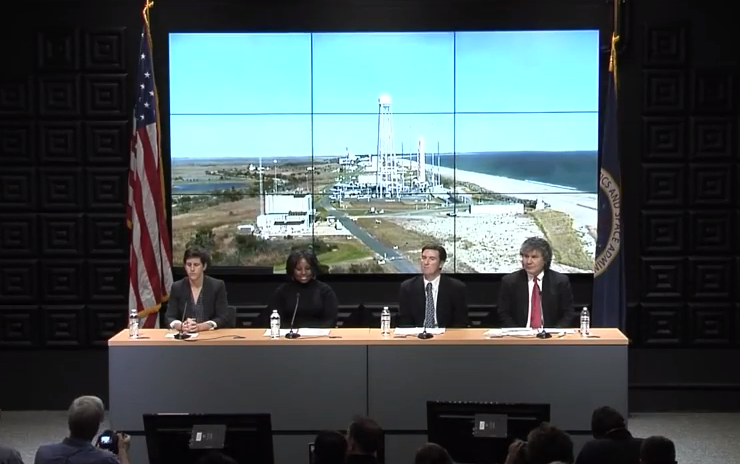
NASA Pre-flight Media Briefing for the launch of Orb-3, NASA Wallops Flight Facility, Wallops Island, VA, October 26, 2014
An Introduction to the Student Spaceflight Experiments Program (SSEP)
Student Spaceflight Experiments Program (SSEP) Mission 8 to the International Space Station (ISS) started Monday, February 23, 2015.. There are 14 participating communities in Mission 8 – 11 in the U.S. and 3 in Canada. Mission 8 to ISS is the tenth SSEP flight opportunity since program inception in 2010, just 4.5 years ago. A list of the Mission 8 communities is provided below.
In support of Mission 8, to help teachers, students, and other stakeholders across each community understand the operation of the SSEP, we are providing this repost of the NASA Pre-flight Science Briefing to media for the launch of the Orb-3 (Orbital Sciences Antares rocket and Cygnus spacecraft). Orb-3 was to carry the SSEP Mission 6 to ISS Yankee Clipper payload of 18 student experiments to the ISS, one from each of the Mission 6 communities, including one community in Canada – School District #73, Kamloops/Thompson, British Columbia. This represented the culmination of 6,860 students engaged in microgravity experiment design, and submission of 1,487 flight experiment proposals from student teams.
The Briefing was conducted at NASA Wallops Flight Facility, Wallops Island, VA, on October 26, 2014, in advance of the launch of Orb-3 from the adjacent Mid-Atlantic Regional Spaceport (MARS). A live video feed of the rocket on Pad-0A can be seen behind the panelists. The Briefing was aired live on NASA TV.
Historical Background: Orb-3 was lost on launch on October 28, 2014 (see December 8, 2014 blog post). A replacement payload of 17 of 18 Mission 6 experiments, Yankee Clipper II, launched to the International Space Station aboard SpaceX CRS-5 on January 10, 2015, at 4:47 am EST, from Cape Canaveral Air Force Station, FL. This truly stunning, just 2-month turn-around was due to the remarkable efforts of all Mission 6 student flight teams, their teacher facilitators, NASA, NanoRacks, and NCESSE. After a month on ISS, Yankee Clipper II retuned to Earth on SpaceX CRS-5 Dragon on February 10, splashing down in the Pacific. All M6 student flight teams now have their flight experiments back, and are harvesting and carrying out analysis.
Dr. Jeff Goldstein, Center Director for the National Center for Earth and Space Science Education in the U.S, Institute Director, Arthur C. Clarke Institute for Space Education, internationally, and the creator and director of the SSEP, was one of the panelists on the Briefing, and provided an excellent overview of the Student Spaceflight Experiments Program, including the breadth and depth of effort put forward at the local level in each of the participating Mission 6 communities. He also provided an overview of the science to be conducted on ISS with the Yankee Clipper experiments. Dr. Goldstein is the NASA Principal Investigator (PI) on all SSEP experiment payloads. Also on the briefing was Brian Talbot, from SSEP National Partner CASIS (Center for the Advancement of Science in Space)
The video provides a wonderful introduction to SSEP for everyone in the Mission 8 communities, and provides a sense of what is to come with the currently projected launch of the Kitty Hawk payload of Mission 8 experiments in Fall 2015.
The backdrop for the Briefing, framed by the American and NASA flags, and with the live feed from the Pad, provides a powerful sense that communities participating in this program are very much a part of America’s and Canada’s Space Program. For each Mission, SSEP is providing real immersion in real science on the frontiers of human exploration for thousands of students.
To all participating in Mission 8 to ISS, welcome aboard, and get used to the expression ‘real spaceflight all the time’ (you’ll be hearing it a lot:)
Pre-Flight Science Briefing – the SSEP Highlights:
SSEP Overview: at time stamp 10 min 50 sec
Question from Ken Kremer, Universe Today, on Sen. Tom Coburn’s (OK) uninformed comments on the SSEP: at time stamp 19 min 25 sec
Goldstein’s response to Ken Kremer’s question: at time stamp 20 min 35 sec (also see NCESSE’s formal response)
The Mission 8 to ISS Communities – Welcome Aboard
Calgary, Alberta, CANADA
Bishop Carroll High School
Calgary Separate School District
Toronto, Ontario, CANADA
Ryerson University
Toronto District School Board (TDSB)
Toronto, Ontario, CANADA
University of Toronto Schools (UTS)
Santa Ana, CA
Mendez Fundamental Intermediate School
Santa Ana Unified School District SAUSD
Vista, CA
Vista Magnet Middle School
Dover, DE
Delaware State University
Boise, ID
Treasure Valley Math and Science Center
Montgomery County, MD
Montgomery County Public Schools
Prince George’s County, MD
Prince George’s County Public School System
Kansas City, MO/KS
aSTEAM Village School Consortium
Elizabeth, NJ
Elizabeth Public Schools
New York City, NY
Intrepid Sea, Air & Space Museum Complex
New York City, NY
New Explorations in Science Technology and Math (NEST+m)
New York City Department of Education
Suffolk County, NY
Wyandanch Union Free School District
South Huntington Schools
The Student Spaceflight Experiments Program (SSEP) is a program of the National Center for Earth and Space Science Education (NCESSE) in the U.S., and the Arthur C. Clarke Institute for Space Education internationally. It is enabled through a strategic partnership with NanoRacks LLC, working with NASA under a Space Act Agreement as part of the utilization of the International Space Station as a National Laboratory. SSEP is the first pre-college STEM education program that is both a U.S. national initiative and implemented as an on-orbit commercial space venture.
The Smithsonian National Air and Space Museum, Center for the Advancement of Science in Space (CASIS), and Subaru of America, Inc. are National Partners on the Student Spaceflight Experiments Program.



